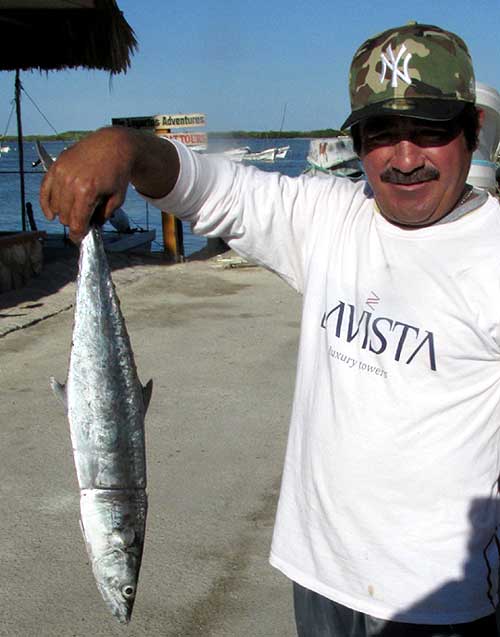Excerpts from Jim Conrad's
Naturalist Newsletter
from the December 28, 2014 Newsletter issued from Río Lagartos, on the Yucatan Peninsula's northern coast (~N21.60°, ~W88.16°), Yucatán state, MÉXICO
KING MACKEREL
That day someone in town must have hit it lucky out fishing because several people appeared in the streets carrying long, silvery fish. And when I stepped out to go buy tortillas, here came a car with my friend Julio dangling his own outside the car window. Below, you can see Julio showing off his treasure, with the end of my street in the background, and the estuary beyond:

I'm a real landlubber so I had no idea what fish it was. Julio called it a Peto, which when Googled turned up a kind of women's bibbed coverall, so for me the ID process had to start from the beginning. And this fish that arrived so ingloriously dangling outside a car window turned out to be royalty among fish species, one of the most sought-after gamefish along the Western Atlantic coast from Canada south through the Gulf of Mexico and Caribbean to Brazil: It's the King Mackerel, SCOMBEROMORUS CAVALLA. It's mostly a tropical and subtropical species so it extends into cooler waters only erratically.
In the picture, it's hard to miss the narrow, ringlike constriction encircling the fish's body about a quarter of the distance back from the head. That's where the fish was caught in the net. Though King Mackerel often are caught on lines using live bait or trolled lures, this one was caught with a gill net, and must have stayed stuck for a long time. Commercially King Mackerel are sold for the making of fishsteaks, or to be canned or salted.
Just by looking at the King Mackerel's smooth, streamlined body it's easy to guess that this fish doesn't lazily wander about the ocean's floor, but rather streaks through its landscape. In fact, King Mackerels are voracious, opportunistic predators of other fish and squid. They keep moving so fast that they have no swim bladder, which is not needed because forward motion keeps the fish where it wants to be. King Mackerels have been documented as long as 6ft (184cm), but usually they're a little less than half that length.
The name "mackerel" is used for a number of normally slender, silvery fish with vertical stripes on their backs and deeply forked tails. "True mackerel" belong to the Mackerel Family, the Scombridae, of which about 21 species are recognized, including the fish known as tunas, which form a subgroup in the Mackerel Family. The best known species thought of as a mackerel is the Atlantic mackerel, Scomber scombrus.
Just from outside appearances I doubt I could distinguish our King Mackerel from closely related species of the same genus. However, the list of fish known from Ría Lagartos Biosphere Reserve bears only two species of Scomberomorus, and one of those is the King Mackerel.
On the day when it seemed that most folks in town got their King Mackerel, I received more than one invitation for a Peto taco, being assured that this was one of the best tasting of all fish, especially when sprinkled with a little hotsauce. And that we vegetarians needn't worry about eating them, because they don't count as meat.